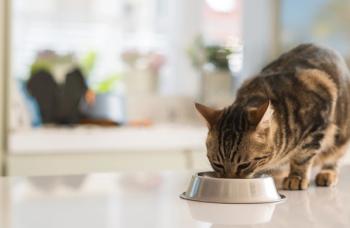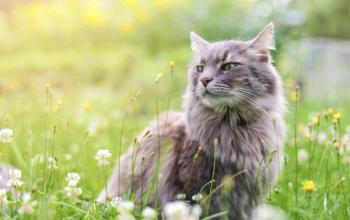
Show sheep recovers from rumen acidosis
Onyx, a 9-month-old experienced show animal, was rushed to UC Davis after becoming acutely ill at a show.
While on the road at a recent show, Onyx, a 9-month-old natural-colored Hampshire cross sheep, fell acutely ill. Onyx, who is already an experienced show sheep, is the latest addition to his owner’s flock, who has been showing sheep as a hobby for almost 10 years.
“After traveling to a show, I could tell Onyx wasn’t feeling well that evening, but I wasn’t terribly worried,” his owner explained to UC Davis School of Veterinary Medicine.1 “But on a walk the next morning, he went down abruptly and could not get back up.”
Onyx was checked out by the onsite veterinarian at the show, who thought he may have been suffering from a urinary blockage, but after treating Onyx, he realized that was not the issue. The veterinarian then administered thiamine and a nonsteroidal anti-inflammatory drug that is used to treat pain in livestock; he then told the family to take their sheep to UC Davis immediately. The family loaded Onyx in the back seat of their truck to save time and made the 3-hour drive to UC Davis.
When he arrived at the UC Davis William R. Pritchard Veterinary Medical Teaching Hospital, he was unable to get up, was abnormally dull, had stiffness in his hind limbs, and showed additional signs of neurologic disease, including seizure activity. Onyx received emergency treatment from the livestock medicine and surgery service team, including antiseizure medication, initiated diagnostic tests, and intravenous (IV) fluid therapy. When his tests came back, his blood work was within reference ranges, and the team ruled out any urinary tract obstructions based on his ultrasound and radiographs of his abdomen. However, a sample from his rumen showed low pH levels, which indicates rumen acidosis, also known as grain overload.
Rumen acidosis is a metabolic disorder in ruminants associated with overingestion or a sudden change to rapidly fermentable concentrate feeds such as barely, corn, or wheat.2 This then causes a drop in rumen pH, causing the damage to the rumen microbes, rumen wall, and could sometimes lead to severe systemic complications like acidosis and bacterial spreading into the blood or other organs.1
UC Davis reported that days before this happened to Onyx, his diet was slightly altered. Because some ruminants are more sensitive to diet changes, this could have caused his acidosis, which kills off the rumens bacteria that synthesize the thiamine needed for ruminants to survive.1 Low thiamine can then cause polioencephalomalacia (PEM; also known as “polio” in ruminants), which is a metabolic disease of the brain that can cause death in severe cases. PEM is a painful condition that can cause affected animals to become blind, be down, or have seizures, leading Onyx’s team to believe this was the cause of his neurological problems.
The UC Davis team treated Onyx’s PEM with thiamine supplementation and magnesium hydroxide to correct the rumen pH, as well as antibiotics to prevent bacteria spreading to his blood from the damaged rumen. He was also given fluid therapy to manage hydration and IV energy supplementation while he was healing. Onyx was also transfaunated with rumen juice from a donor onsite to repopulate his rumen with healthy microbes. Clinically, he improved relatively quickly. Onyx’s mentation went back to normal and after 24 hours of treatment, he could stand on his own.
Onyx remained in the hospital for 4 days before returning home with his owners. They have said he recovered almost 100% neurologically and is eating well. His owners are also helping him to recover from muscle stiffness and to gain weight, as he became 10 lb underweight since becoming ill. Onyx is slowly gaining the weight back and hopes to return to the show ring by October.
References
- Warren R. Award-winning show sheep recovers from grain overload. UC Davis School of Veterinary Medicine. July 28, 2025. Accessed August 14, 2025.
https://www.vetmed.ucdavis.edu/news/award-winning-show-sheep-recovers-grain-overload - Constable P, Lorenz I, Braun U. Grain overload in ruminants. Merck Veterinary Manual. June 2022. Updated September 2024. Accessed August 14, 2025. https://www.merckvetmanual.com/digestive-system/diseases-of-the-ruminant-forestomach/grain-overload-in-ruminants
Newsletter
From exam room tips to practice management insights, get trusted veterinary news delivered straight to your inbox—subscribe to dvm360.






